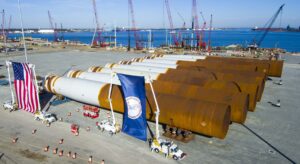New Jersey just agreed to two ocean wind projects with astronomical guaranteed power prices. The price demanded and received by independent competitive suppliers shows there is at least some upside to the utility-owned, captive ratepayer-financed model behind Dominion Energy Virginia’s massive offshore wind facility.
In late 2023 the news was full of reports that independent wind developers were pulling out of various projects along the East Coast because the projects were no longer economically viable. Those who thought the future of the industry was in jeopardy were wrong.
Now with these two agreements, the real price is emerging, and political leaders committed to utopian energy visions are gleefully imposing those higher costs on their citizens. These agreements, outliers now, will become the new standard as other states proceed. The contracts will eventually cost twice as much or more, over time, as the abandoned agreements they replace. Here’s a headline that might prove out of date very soon.
For the second session in a row, Dominion and others just persuaded the General Assembly to kill a bill mandating that Virginia at least seek and consider competitive bids. Dominion plans a second wave of turbines off Virginia Beach, as large as the first. Its argument that this monopoly approach is cheaper overall just got a boost.
The prices in New Jersey, however, should serve as a warning about what that second phase of Dominion’s project may cost. It would be on about the same time schedule. And price is not the only consideration. The difference in the risk imposed by the two approaches remains.
The big disadvantage of the utility-owned, guaranteed repayment approach the General Assembly granted to Dominion is that all the performance risk of the project falls on the ratepayers. If the project fails to meet projected power output, or if a hurricane causes substantial damage, the utility is protected, and the customers keep paying. They could be paying for zero output for long periods.
With the power purchase agreements being used in every other project on our Atlantic seaboard, none of them utility-owned, that risk rests with the developer. No power means no payment. There may be some hedging in the fine print, but basically that is the difference between the two approaches. The risk premium is their excuse for the new, incredible prices.
New Jersey’s utilities will actually be paying these developers for ORECs, ocean renewable energy certificates. News reports indicate one of the developers, TotalEnergies, will receive $131 per megawatt-hour of output in the first year, but with an annual 3% escalator. Plus, depending on construction costs, that initial price could go up another 15%.
Push that out the 20 years of the contract period and the price per megawatt hour could exceed $215 by the end. The second project also includes an annual escalator and construction overrun protection but starts at a slightly lower point.
The projects are also going to be lavishly subsidized by federal taxpayers, of course. That comes out of all of our pockets, not just New Jersey ratepayers, but will be largely invisible.
The math gets complicated, but think of $215 per megawatt-hour as 22 cents per kilowatt hour. Even the starting price of $131 per MWH far exceeds the cost of making electricity from most other sources. That is the price just for the electricity. The price of raw power is less than half the total cost on the typical home or business bill. Bills in New Jersey will soar, faster by far than the costs will soar in Virginia for Dominion’s project (or projects).
The independent producers get to sell the power into PJM Interconnection, and the payments for the electricity are applied against the OREC. So, the subsidy will rise or fall based on the marginal power price, but between them the target price is paid. With wind power there have been times in other markets when the marginal price is zero or below. The subsidy would be 100% on those days.
That still doesn’t mean that if Virginia (foolishly in my opinion) lets Dominion build even more turbines at ratepayer expense, bidding should not occur. It should. Comparison is important.
There is another CVOW-related development that deserves notice. Reports that Dominion has all the federal permits it needs to build the project may qualify as Fake News. One the same day the headline about final approval appeared in Dominion’s hometown sycophant newspaper, the following appeared in my inbox:
PHILADELPHIA (Jan. 30, 2024) – The U.S. Environmental Protection Agency (EPA) announced the opening of a 30-day public comment period on Jan. 29 for a draft Clean Air Act Outer Continental Shelf (OCS) air quality permit for Dominion Energy’s Coastal Virginia Offshore Wind Commercial project located off the coast of Virginia Beach, Virginia…
The proposed permit, fact sheet, and all supporting materials are available for review on the Regulations.gov website.
Information about the permit and virtual public hearing can also be found here.
So, yet another public comment period on a pending permit is open for a month. Is there actually any chance the EPA will not approve this project, which the press release itself praises and identifies as a high priority of the Biden-Harris Administration? No, of course not. The fix is in. We are already paying every month for this project and the monopiles and other parts are being assembled. The federal permitting process is just a game of pretend, so perhaps the claim this is a done deal was not “fake news” after all.


Leave a Reply
You must be logged in to post a comment.